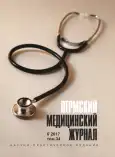Structure of reproductive losses
- Authors: Olina A.A.1, Sadykova G.K.1, Galinova I.V.1
-
Affiliations:
- Academician Ye.A. Vagner Perm State Medical University
- Issue: Vol 34, No 6 (2017)
- Pages: 59-66
- Section: Articles
- URL: https://journals.rcsi.science/PMJ/article/view/7898
- DOI: https://doi.org/10.17816/pmj34659-66
- ID: 7898
Cite item
Full Text
Abstract
Aim. To assess the dynamics of reproductive losses in Perm during the period of 2006 to 2016.
Materials and methods. The following statistical forms were analyzed: 13 “Data on abortion”; 32 “Data on medical care rendered to pregnant, parturient women and puerperas”; 14 “Data on hospital activity” in Perm over the period from 2006 to 2016, taking into account changes in live birth criteria, registered in 2012.
Results. Decrease in reproductive losses is an important reserve for improving demographic situation. Reproductive losses are the losses of conception product at all the stages of fetus development, caused by spontaneous and stimulated abortion, dead birth as well as death of first-year of life children. For the analyzed period, increase in the number of labors by 8 times and reduction in the number of medical abortions (losses - 71 %) was noted. In the structure of pregnancies with abortive outcome, the share of extrauterine pregnancy remains at the same level. A threefold decrease in dead births is observed.
Conclusions. Reproductive losses in Perm are the following: I place - early miscarriage; II - extrauterine pregnancy; III - late miscarriage; IV - mortinatality. The place, occupied by the losses of desired pregnancies, becomes more and more significant. That is why we need to accentuate specialists’ attention on the problems of family planning, pregravid preparation and management of pregnancy at early terms.
Full Text
##article.viewOnOriginalSite##About the authors
A. A. Olina
Academician Ye.A. Vagner Perm State Medical University
Author for correspondence.
Email: olina29@mail.ru
доктор медицинских наук, профессор кафедры акушерства и гинекологии
Russian Federation, PermG. K. Sadykova
Academician Ye.A. Vagner Perm State Medical University
Email: olina29@mail.ru
кандидат медицинских наук, доцент кафедры акушерства и гинекологии
Russian Federation, PermI. V. Galinova
Academician Ye.A. Vagner Perm State Medical University
Email: olina29@mail.ru
аспирант кафедры акушерства и гинекологии
Russian Federation, PermReferences
- Аполихин О.И., Москалева Н.Г., Комарова В.А. Современная демографическая ситуация и проблемы улучшения репродуктивного здоровья населения России. Экспериментальная и клиническая урология 2015; 4: 4-14.
- Бурдули Г.М. Репродуктивные потери (причины, факторы риска, пути профилактики): автореф. дис. … д-ра мед. наук. М. 1998; 47.
- Гусаров В.М. Статистика: учеб. пособие для вузов. М.: ЮНИТИ-ДАНА 2002; 463.
- Кузнецова Т.В. Медико-статистический анализ динамики репродуктивных исходов в России за период 1999-2008 гг. Электронный научный журнал «Социальные аспекты здоровья населения» 2009, аvailable at: http:// vestnik.mednet.ru/content/view/146/lang,ru.
- Кулаков В.И., Прилепская В.Н., Радзинский В.Е. Руководство по амбулаторно-поликлинической помощи в акушерстве и гинекологии 2006; 119-120.
- Приказ Минздравсоцразвития № 1687н от 27.12.11 «О медицинских критериях рождения, форме документа о рождении и порядке его выдачи» (зарегистрировано в Минюсте РФ 15.03.12 №23490), available at: http://base.garant.ru/70113066.
- Стародубов В.И., Суханова Л.П., Сыченков Ю.Г. Репродуктивные потери как медико-социальная проблема демографического развития России. Электронный научный журнал «Социальные аспекты здоровья населения» 2011; 6, available at: http://vestnik. mednet.ru/content/view/367/30/lang,ru
- Сухих Г.Т. Новые технологии в диагностике и лечении гинекологических заболеваний. М.: МЕДИ- Экспо 2011; 304.
Supplementary files






